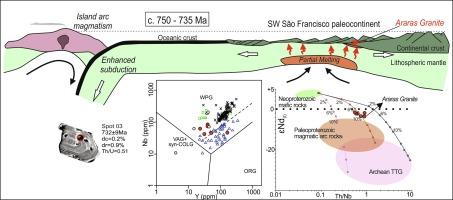圣弗朗西斯科古大陆被动边缘的晚托尼世(约 735 Ma)A 型花岗岩岩浆活动与外侧俯冲同时发生
IF 3.2
2区 地球科学
Q2 GEOSCIENCES, MULTIDISCIPLINARY
引用次数: 0
摘要
晚托尼世(约 735 Ma)A 型花岗岩岩浆活动伴随着圣弗朗西斯科古大陆西南部裂陷大陆边缘的发展。通过锆石 U-Pb 和微量元素、全岩岩石地球化学以及钕-锶同位素,可以对构造环境进行评估。阿拉拉斯花岗岩显示出较高的二氧化硅含量(73% 至 76%)和铁性。Y + Nb 和 Yb + Ta 参数分别介于 73 至 212 ppm 和 8.3 至 19.1 ppm 之间,1000*Ga/Al 比率介于 2.6 至 3.4 之间。锆石 U-Pb 数据显示结晶年龄为 736 ± 12 Ma。εNd(t)略呈负值(介于-3.6和-1.7之间),贫幔模型年龄(TDM)介于1.26和1.56 Ga之间。基于全岩元素和同位素地球化学的二元混合模型表明,花岗岩是由两个来源的熔体混合形成的:岩石圈地幔成分和来自区域基底的古新生代岩浆弧岩。阿拉拉斯花岗岩被认为是大约 840 至 730 万年之间与延伸有关的板内岩浆活动的晚期阶段,与圣弗朗西斯科古大陆西南部裂陷大陆边缘的演化有关。板内岩浆活动与古大陆周围长寿岛弧系统内有记载的岩浆脉冲部分同步。断裂被动边缘的延伸事件可能与外侧俯冲动力学驱动的板块拉力有关。本文章由计算机程序翻译,如有差异,请以英文原文为准。

Late Tonian (c. 735 Ma) A-type granite magmatism on the passive margin of the São Francisco paleocontinent was coeval with outboard subduction
Late Tonian (ca. 735 Ma) A-type granite magmatism accompanied the development of a rifted continental margin in the southwestern portion of the São Francisco paleocontinent. Zircon U-Pb and trace elements, whole-rock lithogeochemistry, and Nd-Sr isotopes enable assessment of the tectonic setting. The Araras Granite shows high silica content (between 73 and 76 %) and ferroan character. The Y + Nb and Yb + Ta parameters vary respectively between 73 to 212 ppm, and 8.3 to 19.1 ppm, and the 1000*Ga/Al ratio varies between 2.6 and 3.4. Zircon U-Pb data indicates a crystallization age of 736 ± 12 Ma. The εNd(t) is slightly negative (between −3.6 and −1.7), and the depleted mantle model ages (TDM) range between 1.26 and 1.56 Ga. Binary mixing models based on whole-rock element and isotope geochemistry indicate that the granite was formed by mixing melts derived from two sources: a lithospheric mantle component and Paleoproterozoic magmatic arc rocks from the regional basement. The Araras Granite is concluded to represent a late stage of extension-related intraplate magmatism between ca. 840 and 730 Ma, associated with the evolution of a rifted continental margin in the southwestern São Francisco paleocontinent. Intraplate magmatism was partially synchronous with documented magmatic pulses within long-lived island arc systems that surrounded the paleocontinent. Extensional episodes in the rifted passive margin may be related to slab-pull forces driven by the outboard subduction dynamics.
求助全文
通过发布文献求助,成功后即可免费获取论文全文。
去求助
来源期刊

Precambrian Research
地学-地球科学综合
CiteScore
7.20
自引率
28.90%
发文量
325
审稿时长
12 months
期刊介绍:
Precambrian Research publishes studies on all aspects of the early stages of the composition, structure and evolution of the Earth and its planetary neighbours. With a focus on process-oriented and comparative studies, it covers, but is not restricted to, subjects such as:
(1) Chemical, biological, biochemical and cosmochemical evolution; the origin of life; the evolution of the oceans and atmosphere; the early fossil record; palaeobiology;
(2) Geochronology and isotope and elemental geochemistry;
(3) Precambrian mineral deposits;
(4) Geophysical aspects of the early Earth and Precambrian terrains;
(5) Nature, formation and evolution of the Precambrian lithosphere and mantle including magmatic, depositional, metamorphic and tectonic processes.
In addition, the editors particularly welcome integrated process-oriented studies that involve a combination of the above fields and comparative studies that demonstrate the effect of Precambrian evolution on Phanerozoic earth system processes.
Regional and localised studies of Precambrian phenomena are considered appropriate only when the detail and quality allow illustration of a wider process, or when significant gaps in basic knowledge of a particular area can be filled.
 求助内容:
求助内容: 应助结果提醒方式:
应助结果提醒方式:


